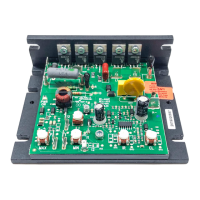WARNING: If control is wired to a transformer, do not switch the primary side of transformer to disconnect power or catastrophic
failure can result. Always disconnect control from secondary side of transformer.
CAUTION: Do not bundle potentiometer connections (P1, P2, P3) and Inhibit™ connections (I1, I2) with AC line or motor wires.
WARNING: Armature Switching. Do not switch the armature in and out of circuit or catastrophic failure will result. If armature
switching is required for dynamic brake or reversing, use model KBRG, KBPB or KBCC-R suffix controls.
NOTE: (Shunt motors only) For 90V DC motors with 50VDC fields and 180VDC motors with 100VDC fields, use half voltage
field connections F+ and L1. (See table 7, p. 8)
C. Voltage Following – All models can be controlled with an isolated analog reference voltage (0-7 VDC) in lieu of the main
speed potentiometer. The voltage is connected to P2 (+) and F-. The control output voltage will linearly follow the input voltage.
The source impedance of the input should be 10K ohms or less. The Min and Max trimpots are rendered inoperative in the
voltage following mode. Use auxiliary trimpots for scaling and to limit the control range. If the input signal is not isolated, or
is a current signal (4 - 20 mA), the KBSI-240D or SI-5 Barrier Terminal Board Signal Isolator must be used. It will allow direct
connection to process controllers and microprocessors.
CAUTION:
1. The voltage feeding P2 and F- must be isolated from the AC line. Do not earth ground P2 or F- to setup a zero or ground
reference.
2. Do not bundle signal wires to P2 and F- with AC line or motor connections. If signal wires are over 18 inches, use shielded
cables.
D. Fusing – The KBIC
®
has provision for adding a built-in AC line fuse and armature fuse*. The AC line fuse protects the control
against catastrophic failure. If the fuse blows, the control is miswired, the motor is shorted or grounded, or the KBIC
®
control
is defective. The armature fuse provides overload protection for the motor and control. Choose the proper size armature fuse
and AC line fuse (see fuse chart table 4, p. 5) by multiplying the maximum DC motor amps by 1.7. Armature and AC line fuse
kits are available from your distributor. On domestic 230 Volt AC lines, separate branch circuit protection for each line must
be used. All fuses should be normal blow ceramic 3AG or MDA or equivalent. The Barrier Terminal Kit (optional) contains
prewired AC line and armature fuses. *Contact your distributor.
9
FIG. 4 – ACCEL TRIMPOT ADJUSTMENT
III. ADJUSTMENTS AND CONTROL FUNCTIONS
The KBIC
®
is factory adjusted to provide 0 to full speed range using a 5K potentiometer. Minimum and maximum speed trimpots
are provided to change the speed range from other than 0 to full speed. An acceleration start (located directly behind the MIN
trimpot) is factory set to provide motor acceleration from 0 to full speed over a time period of 2 seconds (approx.) each time the
AC power is applied. The current limiting (CL, or torque output) adjustment is factory set to approximately one and a half times
the motor rating. The IR Compensation (IR) is factory adjusted to provide excellent motor regulation under normal operation.
NOTE: In order for the IR comp and CL trimpot settings to be correct, the proper Plug-in Horsepower Resistor
®
must be
installed for the particular motor and input voltage being used. Do not attempt to change the settings of the trimpots
unless absolutely necessary since they are factory adjusted to near optimum settings.
IMPORTANT NOTE:
Readjusting the ACCEL time will affect the MAX speed and IR Comp. settings which will have to be readjusted (see
this Section). If the ACCEL time is decreased to the minimum time of 0.5 seconds (6 o'clock trimpot position), then
increase the IR trimpot 25% CW rotation and decrease the MAX trimpot 20% CCW rotation. If the ACCEL time is
increased to the maximum time of 4 seconds (full rotation), then decrease the IR and increase the MAX as per
above percentages of rotation.
The following procedure is presented in required order of adjustment.
It should be followed when readjusting all trimpot functions:
A. Acceleration Start – (ACCEL trimpot is located directly behind the
MIN trimpot.) If the ACCEL is to be readjusted to different times,
adjust the trimpot to the desired time according to fig. 4.
B. Maximum Speed Adjustment – Set main speed pot to full speed
(maximum CW position). Adjust MAX speed trimpot to new desired
setting.
Note: Do not attempt to adjust the MAX speed above the rated motor
RPM since unstable motor operation may occur. For moderate
changes in the MAX speed, there will be a slight effect on the
MIN speed setting when the MIN speed is set at zero. There
may be significant variation in the MIN speed setting if the MIN
speed is at a higher than zero setting.
C. Minimum Speed Adjustment – If a higher than zero speed is desired, readjust the minimum speed by turning the main
speed potentiometer to zero setting (full CCW position). Then adjust the MIN speed trimpot to the desired setting.
10

